Attention: This post has been written by @getonthetrain
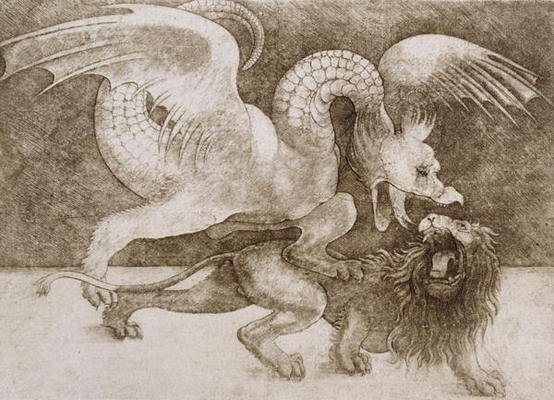
PART 4:
In 1478, after Leonardo’s return from his 2 year disappearance, he no longer worked with Verrocchio. Instead he took up residence with the Medici and worked in their academy, the Garden of the Piazza San Marco, working on some smaller art projects and starting on his never finished pieces The Adoration of the Magi and St Jerome in the Wilderness.
In 1482, Leonardo was said to have created a silver lyre in the shape of a horse’s head. There is no record of this except by the first biographer of his life, Giorgio Vasari, in his 1550 book. Today some think it was made from a horse’s skull covered in silver. Lorenzo de Medici sent Leonardo to deliver the lyre to the Duke of Milan, Ludovico Sforza as a gift of peace. While there, 30 year old Leo sought to be employed by the Duke. To achieve this he wrote an amazing letter explaining his many talents and ways he could serve.
Most Illustrious Lord, Having now sufficiently considered the specimens of all those who proclaim themselves skilled contrivers of instruments of war, and that the invention and operation of the said instruments are nothing different from those in common use: I shall endeavor, without prejudice to any one else, to explain myself to your Excellency, showing your Lordship my secret, and then offering them to your best pleasure and approbation to work with effect at opportune moments on all those things which, in part, shall be briefly noted below.
- I have a sort of extremely light and strong bridges, adapted to be most easily carried, and with them you may pursue, and at any time flee from the enemy; and others, secure and indestructible by fire and battle, easy and convenient to lift and place. Also methods of burning and destroying those of the enemy.
- I know how, when a place is besieged, to take the water out of the trenches, and make endless variety of bridges, and covered ways and ladders, and other machines pertaining to such expeditions.
- If, by reason of the height of the banks, or the strength of the place and its position, it is impossible, when besieging a place, to avail oneself of the plan of bombardment, I have methods for destroying every rock or other fortress, even if it were founded on a rock, etc.
- Again, I have kinds of mortars; most convenient and easy to carry; and with these I can fling small stones almost resembling a storm; and with the smoke of these cause great terror to the enemy, to his great detriment and confusion.
- And if the fight should be at sea I have kinds of many machines most efficient for offense and defense; and vessels which will resist the attack of the largest guns and powder and fumes.
- I have means by secret and tortuous mines and ways, made without noise, to reach a designated spot, even if it were needed to pass under a trench or a river.
- I will make covered chariots, safe and unattackable, which, entering among the enemy with their artillery, there is no body of men so great but they would break them. And behind these, infantry could follow quite unhurt and without any hindrance.
- In case of need I will make big guns, mortars, and light ordnance of fine and useful forms, out of the common type.
- Where the operation of bombardment might fail, I would contrive catapults, mangonels, trabocchi, and other machines of marvellous efficacy and not in common use. And in short, according to the variety of cases, I can contrive various and endless means of offense and defense.
- In times of peace I believe I can give perfect satisfaction and to the equal of any other in architecture and the composition of buildings public and private; and in guiding water from one place to another.
- I can carry out sculpture in marble, bronze, or clay, and also I can do in painting whatever may be done, as well as any other, be he who he may.
Again, the bronze horse may be taken in hand, which is to be to the immortal glory and eternal honor of the prince your father of happy memory, and of the illustrious house of Sforza.
And if any of the above-named things seem to anyone to be impossible or not feasible, I am most ready to make the experiment in your park, or in whatever place may please your Excellency - to whom I comment myself with the utmost humility, etc.
But why did Leonardo, who was a likely a vegetarian and a pacifist and wrote that war is a ”most bestial madness”, want to be employed by one of the most active warlords of Italy? It was because he was given a set salary, he no longer needed to rely on only selling his art. This allowed him to pursue his research and perfect his art without any deadlines. If you read his letter again you can see that he is appealing to the Ludovico’s war lust, with only a snippet of his skills as an artist.
It was during employment with the Duke and other patrons that he was able to devote so much time to study anatomy, flight, and other sciences that we know him for today. The price was the invention of weapons that killed. Numerous scientists and engineers from historical times to the present day have done the same.
From the time of his employment with the Duke of Milan until he was an old man he created many weapons of war for use on the battlefields and sieges of Italy and beyond.
GIANT CROSSBOW
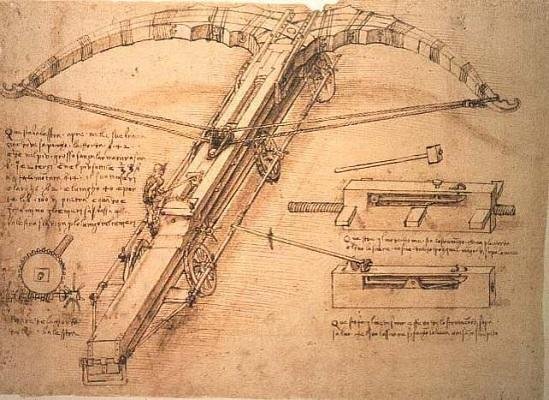
This enormous 86ft long and 81ft wide crossbow was said to only need two people to operate, one to crank and fire it, and one to load the projectile. It was designed with six slanted wheels to better move over rough terrain. The two pictures to the left show two ways to trigger this beast, one using a hammer, and the other by pulling down on a long handle to lift the pin. The sheer size of this thing would have scared the hell out of any enemy. No record exists that this was built until a replica was made by a British team – who couldn’t get the thing to fire more than 16ft without adding extra parts which then allowed a range of only 65ft.
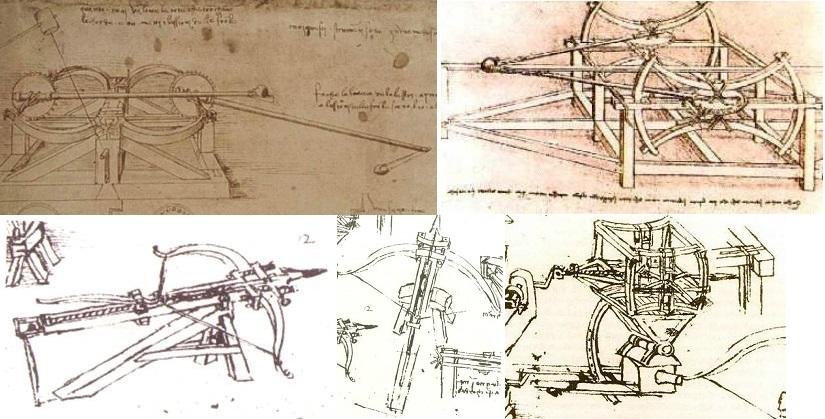
He also drew larger than normal springalds and crossbows swivel mounted on tripods, maybe twice or three times the size of a person. These could have been placed on the walls and towers for defense. Experimenting with how the springalds worked, he developed a ‘bowed’ version and what is known as a ‘double onager’. The onager had two arms on the outside of the machine, one with a sling the other without. This was because if the second arm had a sling it would hang in the path of the first arm.
TRIPLE BARREL CANNON
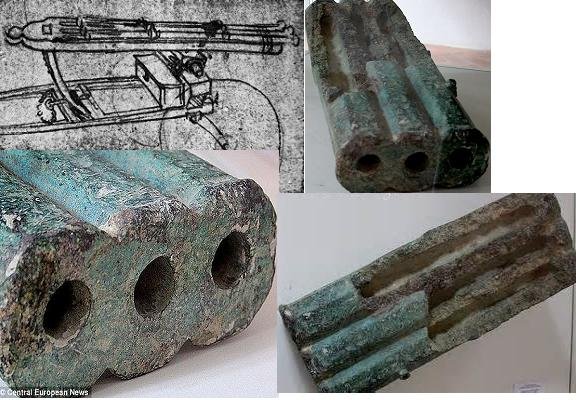
Leonardo designed this device to be much lighter than the cannons of the day so as to be mobile on the battlefield. Having three barrels was his way of compensating for slow reload times, it was loaded from the front and each barrel could be fired independently. The cannon was also able to be elevation adjusted for aiming purposes. One of these was discovered in a fort in Croatia in 1968, the only known surviving Da Vinci invention.
33 BARRELED GUN ORGAN
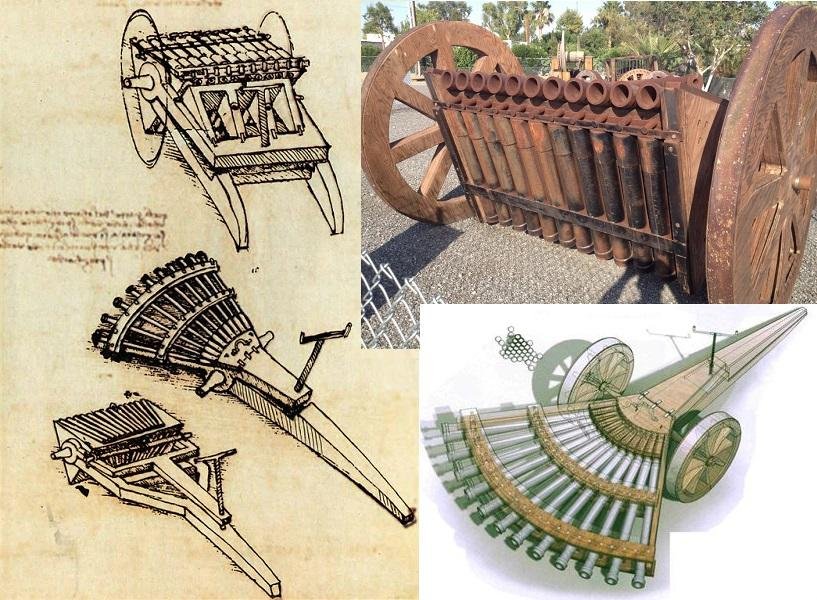
This device featured 3 rows of 11 smaller handheld type cannons on a triangle shaped rotating mechanism. One row would be in position to be fired, the next would be below cooling off, and the final row would be reloading. This enabled the soldiers to keep a continuous rain of firepower on the enemy. This was actually created in Leonardo’s time and it worked! The name for this type of weapon is Ribauldequin.
Another of his guns drawn on the same page had 8-10 guns fanned out to spray death upon any unfortunate soul in the firing arc. It featured a screw angle adjustment to raise or lower the guns.
COVERED CHARIOT or TANK
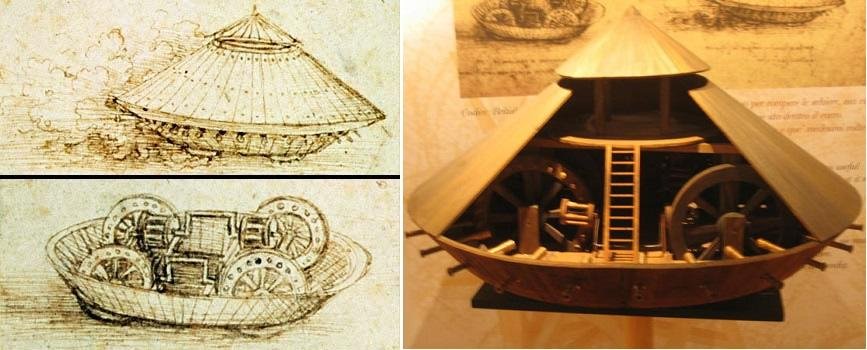
Designed in 1487 this creation featured 32 light cannons all the way around, wood planks reinforced with metal and slanted to deflect shots, and a top turret for visibility. It was designed for 8 men to operate and fire the guns. Leonardo initially considered using a horse to move it, but was concerned about how the animal would react inside the vehicle. This would have only been able to be used on flat, solid ground as any rough terrain would have made it nearly immobile. If you study the design of the gears the way it is drawn the forward and rear wheels would operate in conflict, people believe this was done intentionally in case his designs were stolen. It is not believed to have been built in Leonardo’s time, but a British team built one for the BBC in 2002.
SCYTHED CHARIOT
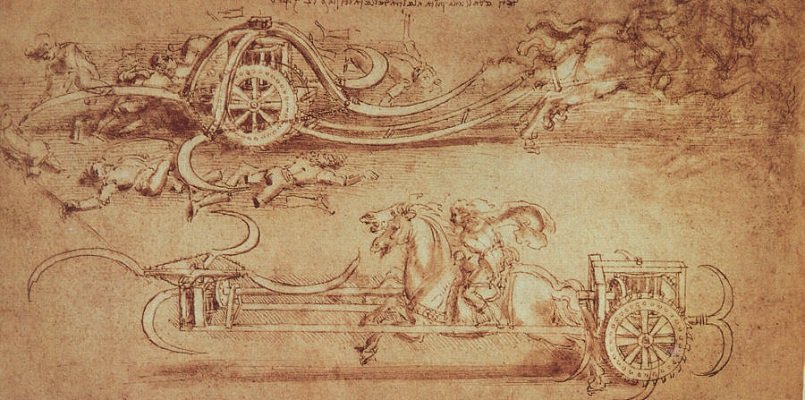
Leonardo drew two versions of a scythed chariot, and the carnage to human life it would cause, with great detail - this was most likely to impress Duke Ludovico. The horse powered vehicles would turn the wheels that were attached to poles and gears that rotated the scythes. With this device he suggested that when around friendly forces the blades should be raised because they ”often did as much injury to friends as they did to enemies”.
CROSSBOW ‘MACHINE GUN’

While this looks like a waterwheel it is in fact an automatic crossbow loading system. He created two versions, one with 4 crossbows and one with 16. It was designed for four men, behind a protective shield, to move along the top of it and a series of gears, pulleys, and ropes caused the bows cord to be tightened with every rotation. The 16 crossbow version was powered by hand cranks.
HUGE BRONZE CANNON
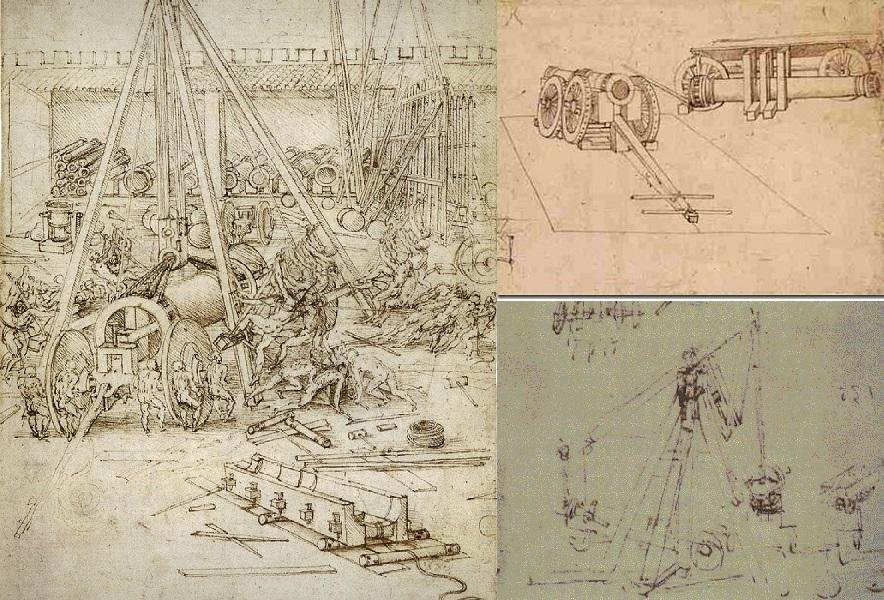
Nothing gets a war hungry leader going like HUGE weapons. One of Leonardo’s sketches shows a mammoth cannon that is being moved through a foundry by dozens of men who are dwarfed by the size of the thing. This sketch takes up a whole page, very unlike Leo’s normal engineering diagrams, so it was most likely drawn to impress the Duke. It is very possible that Leonardo knew of the Great Ottoman Bombard said to be responsible for the fall of Constantinople in 1453, as his drawing is similar in design. The Ottoman cannon was claimed to weigh 700 tons and take 100 bulls and 100 men to move and operate it. It could fire a 1.2 ton stone ball 1 mile. Imagine that thing smashing into your house.
He also invented a way to load and unload this for an army on the move. Since the carriage on the battlefield had to be strong to handle the recoil of this thing firing, it was heavy and more awkward to move – especially over long distances. Leonardo created a system to easily remove this from the battle carriage and transfer it to a wagon cart for travel using a hoist system. Without the weight of the cannon the battlefield carriage would be much easier to bring along, increasing the speed of the march.
STEAM CANNON ‘ARCHITONNERRE’
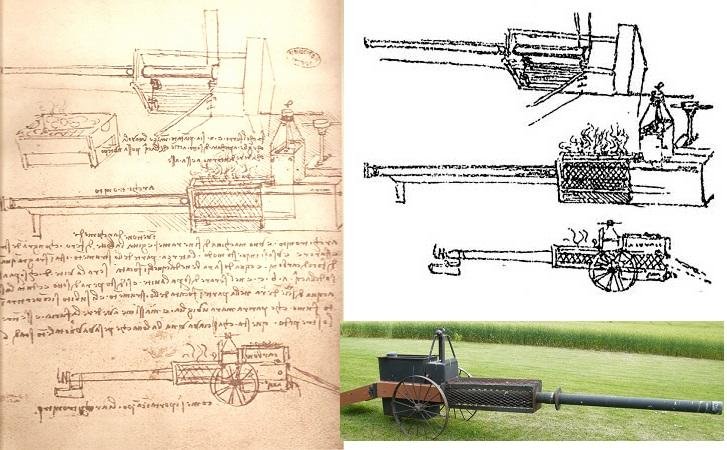
Leonardo’s own words ”Invention of Archimedes (during the siege of Syracuse 214-212BC) — The Architonnerre is a machine of fine copper, which throws balls with a loud report and great force. It is used in the following manner: One third of this instrument contains a large quantity of charcoal fire. When the water is well heated, a screw at the top of the vessel which contains the water must be made quite tight. On closing the screw above, all the water will escape below, will descend into the heated portion of the instrument, and be immediately converted into a vapor so abundant and powerful, that it is wonderful to see its fury and hear the noise it produces. This machine will carry a ball of a talent (32kg) in, weight."
TRENCH EXCAVATOR
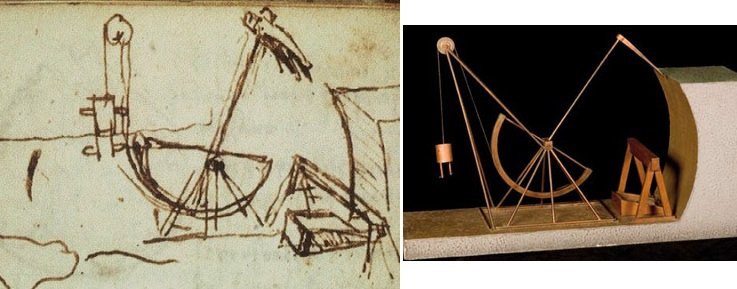
Using a system of weights and counterbalances this machine would be able to work almost without human effort. It would be able to dig a trench to drain a moat, or even dig tunnels underneath the defenses.
MULTIPLE SLING
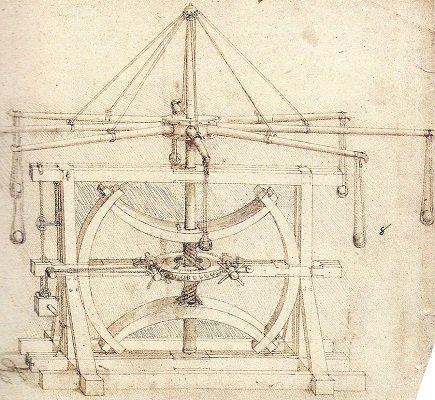
Look at this thing! Eight arms holding slings that would hurl stones at your enemies. It worked by having two or four people winding a system not unlike two crossbows. The winding would bend the crossbow heads down, tightening a rope around a central pole. When released (Da Vinci rightly made the release mechanism active by pulling on a long rope, so to be nowhere near it when it went off) the rope would unwind, spinning the pole and the arms attached to it. When it spun fast enough, the slings would send the stones flying! Where to? All over would be my best guess. This was designed to be a cheap defensive weapon. Needing only wood and rope and a small amount of metal parts in key places, like the release pin, to build it.
LONG RANGE CATAPULTS & TREBUCHETS
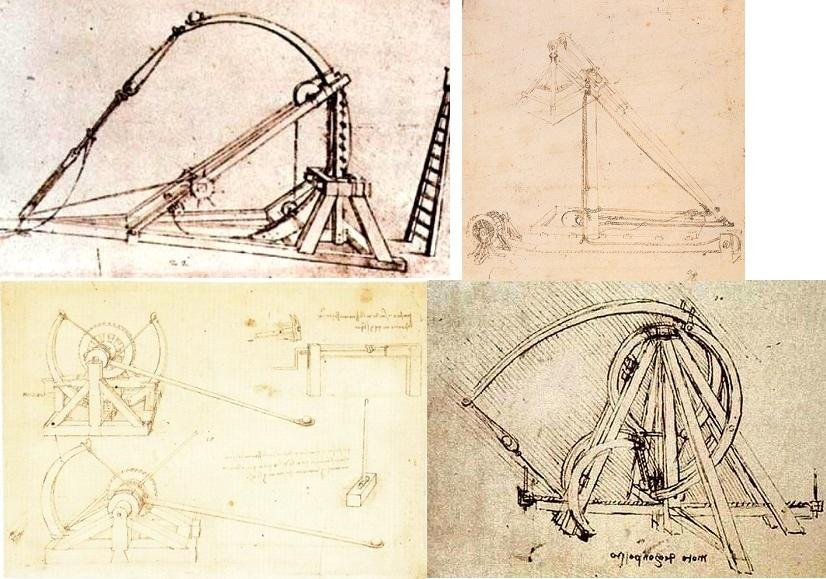
He not only invented completely new weapons, he also improved upon existing ones. By turning a hand crank on the side of the machine a person could store power by bending inward two leaf springs, and when the springs were released they pulled a rope that was spun around a central drum mechanism. In this way Leo has increased the range and ease of use of the common catapult.
Another design is referred to as the simple spring catapult. By pulling back the top of an arm using a block and tackle system the arm is bent storing energy. When released it throws two projectiles, one in the cup and one in a sling. The ranges would be different, as the sling load would travel much further. Loading would have to be done by the ladder drawn nearby, and a pulley system about halfway up the arm might be used to restrain the arm to adjust the angle of launch.
Using the same concepts as the simple spring catapult, this one is referred to as the complex version. By using a three spring system, Leonardo has made this catapult much smaller, but just as powerful. It is powered by two people turning handles on either end, twisting a rope that pulls everything together. The projectile rests in a sling, further increasing the possible range of this design.
In this design for a trebuchet, Leonardo has created one around a thick pole planted into the ground (or a tree if there was one in range). Other than that detail, it isn’t too different than the ones in use then. It may have been drawn just to show that he is able to do make a trebuchet as well.
PROJECTILES
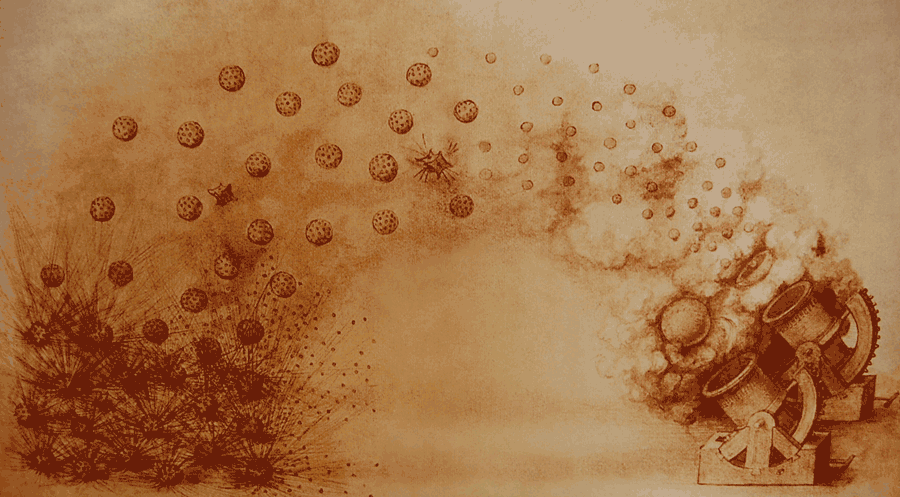
Leonardo came up with this design of a cluster bomb. Packed inside a tightly stitched leather ball were a number of smaller orbs filled with grapeshot. Upon firing, the large first ball would open during flight, then the smaller balls would disperse in a small cluster of bomblets until the final impact when the grapeshot would explode out and cause terrible damage to the enemy.

He also designed projectiles that appear very modern. Instead of the round ball shape of the time these are bullet shaped and hollow to be filled with gunpowder. He even designed some having fins for stability! Similar missiles were designed again in the early 1800s, more than 300 years after Leonardo imagined them.
As well as calculate the angles needed to carpet bomb a city.
WALL DEFENSE
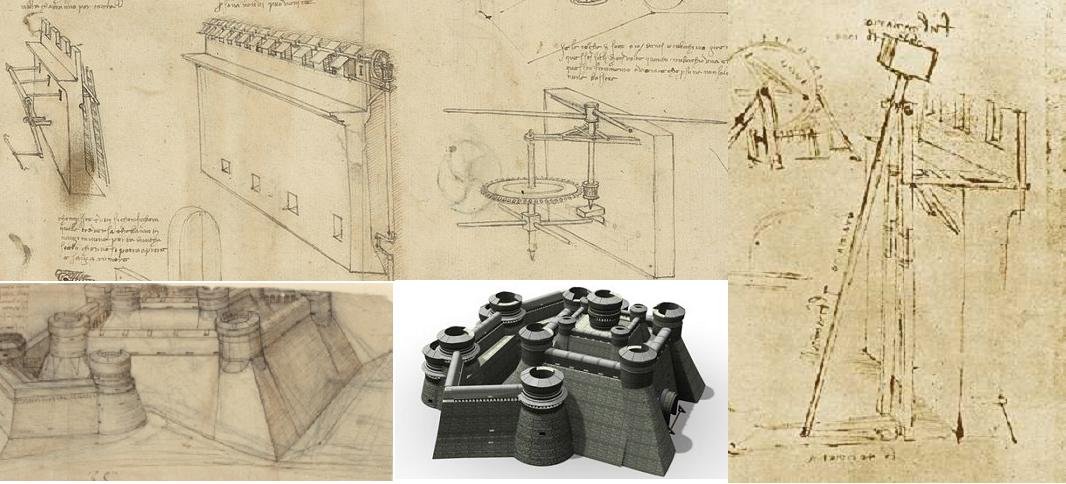
Defensive trebuchets were one of his designs. This one used the height of the walls to give it a longer range, but based on the drawing would only be able to throw in a straight line and only lighter stones at the enemy. Still enough to hinder the enemy attempts at setting up their own artillery. A system of these could develop an overlapping field of fire negating some of its weaknesses.
He also sketched a [LEFT]system where enemy ladders could be pushed off in mass and from behind protective cover. Holes in the wall would support a bar that would be pushed out rapidly if the enemy attempted to set ladders against the wall. A [CENTER]system that would flick assaulters off the wall by attaching boards to a long shaft attached to a gear and handle. Also a [RIGHT]design for a spinning rods to be just over the top of the wall to whack an enemy trying to climb over.
He even designed an improved fortress to withstand the new gunpowder weapons. Slanting the walls and rounding the tops of the battlements help deflect cannon fire. Complete with secret entrance.
PORTABLE BRIDGES
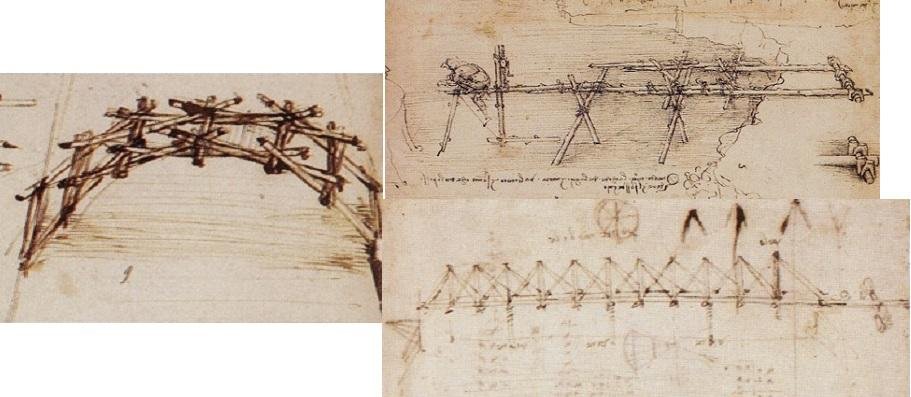
Often an army on the march would encounter a river that they needed to cross without any bridges nearby. If they couldn’t find a ford, or the river was too deep it could cause a long delay. Leonardo came up with a few solutions for this. One was a bridge that supported itself! The army could cut down trees, place them like Leonardo drew, lash them together for safety, and that’s it. The design used the law of statics, that when the load is doubled friction also doubles – which means when weight is applied downward, it got tighter and stronger.
This is his design for a portable suspension bridge, able to be expanded out across a river. The army would first send builders out into the water to plant support poles shown in the sketch. Then they could extend out the bridge and attach it to the supports.
CASTLE ASSAULT

Leo designed this armored siege tower to assault the enemy fortifications. Using a system of gears and ropes, the bridge would initially be raised for the approach and lowered on top of the walls. Soldiers could then charge the walls under some cover from enemy fire. It looks to be moved into position from the inside by an ox.
Another siege tower/ladder design is based off a trebuchet, move the base into position and ‘launch’ the ladder towards the wall you wish to assault.
If the walls of the fortress cannot be reached by the siege towers he created ladders with grappling hooks. Also a system by which a man would screw in metal stakes and create a ladder directly into the wall. It must have been created for a stealth attack because I can’t see someone making that work while under fire.
PERSONAL WEAPONS
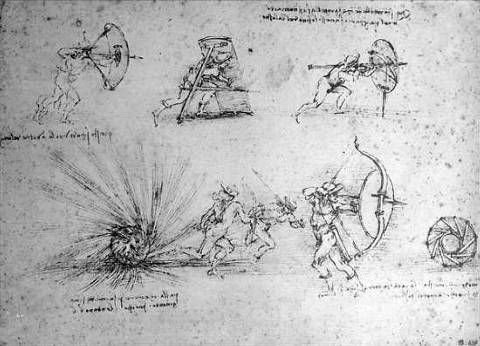
He also created many improvements and experimental designs of handheld weapons, such as a fast loading crossbow, bows with built in shields, and advanced lance tips.
Thank you for reading part 4 of my chronicles of the great Leonardo Da Vinci! This post took me over two days to fully research, making sure I made no errors and collected all the special inventions he created. You will find no other similar collection of his work on any other site, if you don't believe me - google it.
Remember to FOLLOW @getonthetrain to catch the latest releases as they are published!
Click HERE to read article one: Leonardo Da Vinci - Inventions of Flight
Attention: This post has been written by @getonthetrain
@knozaki2015 features authors and artist to promote them and a diversity of content.
The author will receive 100% of the STEEM Dollars from this post
Don't just follow me, follow the author as well, if you like this post @getonthetrain
